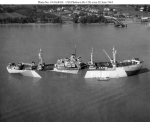 USS Phobos (AK-129) at anchor in the Mississippi River near New Orleans, LA., circa 20 June 1944. A troop carrier, this ship was the only one of this class converted by the War Shipping Administration instead of the Navy. Note the platform on the bow for two 40 mm guns side by side, and the numerous minor differences in configuration compared to her sisters. | |
| History | |
|---|---|
| Name |
|
| Namesake | |
| Ordered | as a type (EC2-S-C1) hull, MCE hull 1961, SS Joseph H. Kibbey |
| Builder | Todd Houston Shipbuilding Co., Houston, Texas |
| Laid down | 25 September 1943 |
| Launched | 6 November 1943 |
| Sponsored by | Mrs. J. S. Burrows |
| Commissioned | 12 June 1944 |
| Decommissioned | 22 March 1946 |
| Refit | converted for Naval service at Todd-Johnson Dry Docks, Inc., New Orleans, LA. |
| Stricken | 17 April 1946 |
| Identification | Hull symbol:AK-129 |
| Fate | Sold for scrapping, 20 February 1970 |
| General characteristics [1] | |
| Class & type | Crater-class cargo ship |
| Displacement |
|
| Length | 441 ft 6 in (134.57 m) |
| Beam | 56 ft 11 in (17.35 m) |
| Draft | 28 ft 4 in (8.64 m) |
| Installed power |
|
| Propulsion |
|
| Speed | 12.5 kn (23.2 km/h; 14.4 mph) |
| Complement | 206 |
| Armament |
|
USS Phobos (AK-129) was a Crater-class cargo ship commissioned by the U.S. Navy for service in World War II. She was responsible for delivering troops, goods and equipment to locations in the war zone.
Contents
- World War II Pacific Theatre operations
- Supplying ships for the invasion of Leyte
- Supporting the 5th fleet
- End-of-war activity
- Post-war decommissioning
- Military awards and honors
- References
- External links
Phobos (AK–129) was laid down as SS Joseph H. Kibbey under Maritime Commission contract by Todd Houston Shipbuilding Co., Houston, Texas, 25 September 1943; launched 6 November 1943; sponsored by Mrs. J. S. Burrows; and delivered to the Maritime Commission 17 November 1943 for operation by the American Export Lines. Following one cruise as a merchant vessel, SS Joseph H. Kibbey was acquired by the Army Transportation Service for use as a troop transport. While under conversion at Todd-Johnson Dry Docks, Inc., New Orleans, Louisiana, she was reassigned to the Navy and named Phobos 15 January 1944. She was accepted by the Navy 12 June 1944 and commissioned the same day at Algiers, Louisiana.